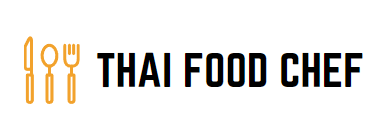Roti Gluay - Thai Banana Pancake With Condensed Milk
You'll find roti gluay at countless Thai street food stalls, where skilled vendors transform simple flatbread into a mouthwatering treat. This fusion dessert combines Indian roti-making techniques with Thai ingredients - featuring thin, crispy dough wrapped around sweet ripe bananas, then grilled to golden perfection. Each bite delivers layers of textures: crispy exterior, soft interior, and creamy condensed milk drizzle. Master the authentic techniques to recreate this beloved street food at home.
Key Takeaways
- Roti gluay is a popular Thai street food that combines Indian-style flatbread with sweet bananas and condensed milk.
- The dish requires simple ingredients: flour, coconut milk, eggs, bananas, butter, and condensed milk for drizzling.
- Cook by spreading thin dough on a hot griddle, adding bananas, folding into squares, and cooking until golden brown.
- The perfect roti gluay balances a crispy exterior with a soft interior and sweet banana filling.
- Top the finished pancake with warm condensed milk and optional extras like chocolate spread or peanut butter.
History
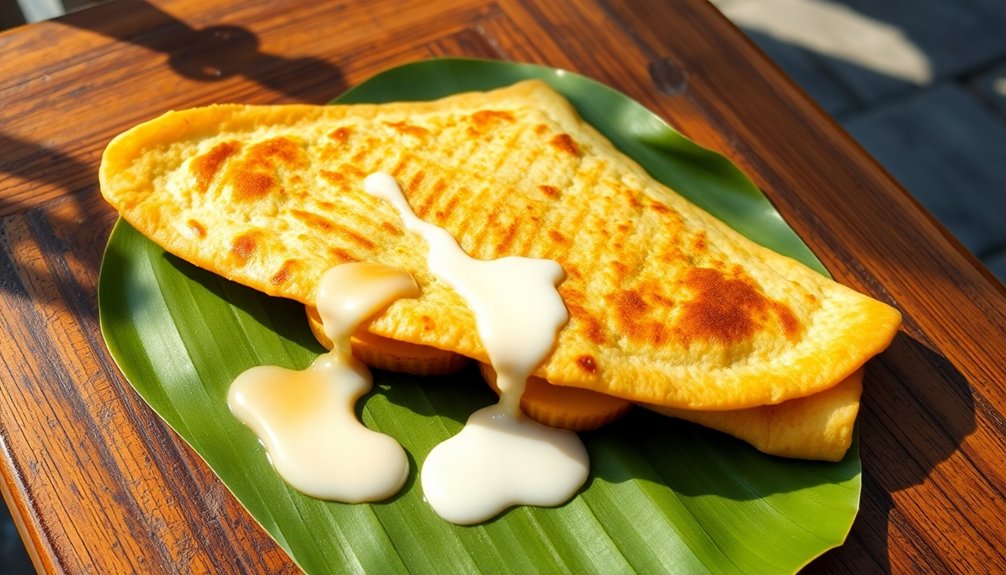
Roti gluay emerged in Thailand as a fusion of Indian roti flatbread and Southeast Asian cooking traditions. The culinary origins of this beloved street food can be traced back to Indian Muslim traders who brought their roti-making techniques to Thailand centuries ago.
Local vendors adapted the recipe by adding sweet Thai bananas and condensed milk, creating a unique dessert that perfectly blends South Asian and Thai flavors.
The cultural significance of roti gluay extends beyond its taste - it's become a symbol of Thailand's diverse culinary heritage.
You'll find it sold by street vendors who've perfected their craft through generations, especially in Bangkok's bustling markets and along busy thoroughfares.
The dish represents how Thai cuisine has historically embraced foreign influences while maintaining its distinctive character.
Recipe
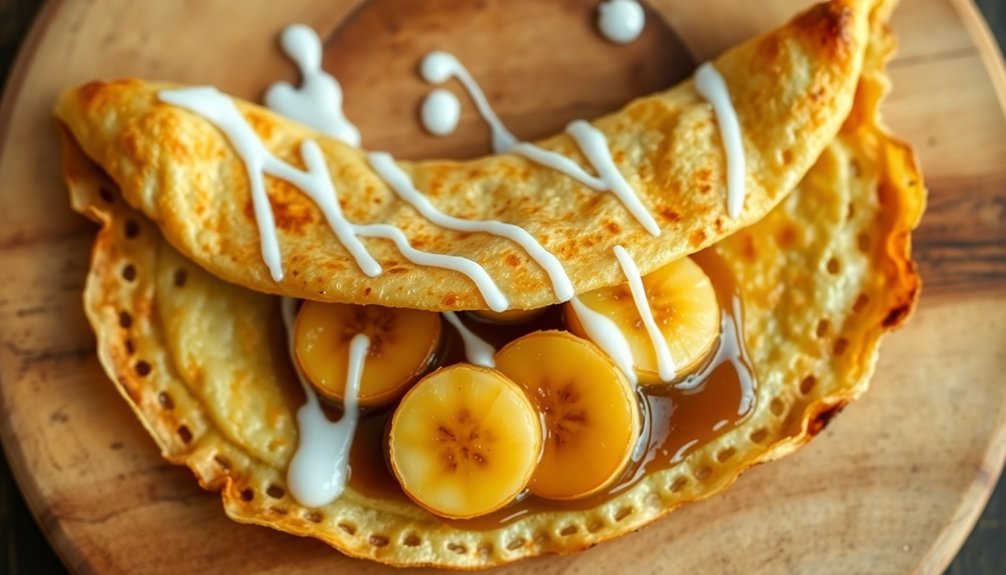
Recipe:
Ingredients:
- 1 cup all-purpose flour
- 1 cup coconut milk
- 1 egg
- 2 tablespoons sugar
- ¼ teaspoon salt
- 2 ripe bananas, sliced
- 2 tablespoons butter, melted
- Condensed milk for drizzling
- Oil for cooking
Instructions:
- Mix flour, coconut milk, egg, sugar, and salt in a bowl until smooth.
- Heat a non-stick pan over medium heat.
- Brush pan with oil.
- Pour ¼ cup of batter and spread into a thin circle.
- Place banana slices on one half of the pancake.
- When edges start to brown, fold pancake in half.
- Brush top with melted butter.
- Flip and cook other side until golden brown.
- Remove from heat.
- Cut into triangles.
- Drizzle with condensed milk.
- Serve hot.
Cooking Steps
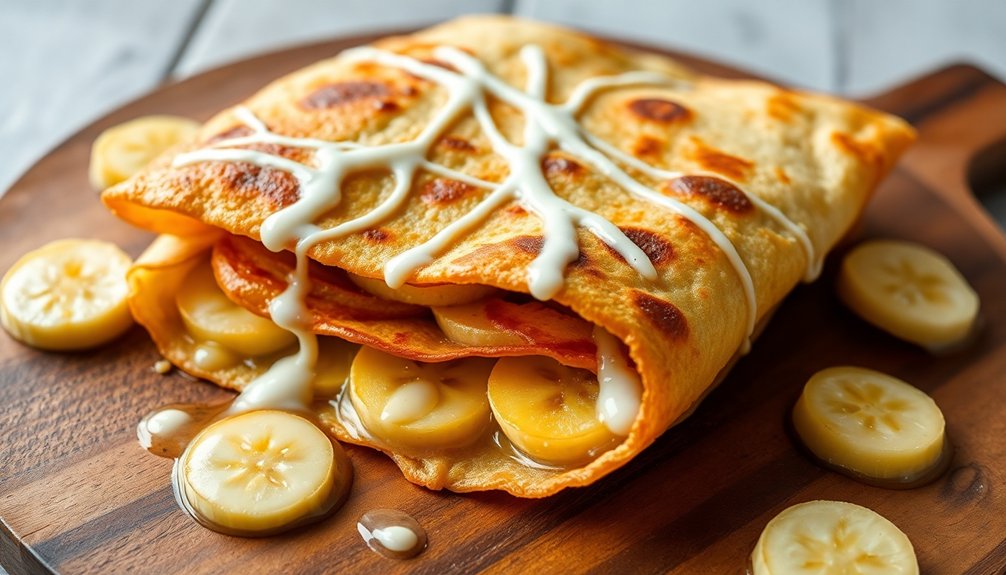
You'll start by mixing the flour and water until you achieve a smooth, lump-free batter that flows easily.
Next, spread the dough thinly to the edges of your hot griddle and arrange fresh banana slices in the center before folding the edges inward to form a neat square shape.
Finally, drizzle warm condensed milk over your crispy roti gluay, allowing it to seep into the layers and create that signature Thai street food experience.
Step 1. Mix Flour and Water Thoroughly
To begin the essential first step, combine 2 cups of all-purpose flour with 1/2 cup of lukewarm water in a large mixing bowl.
You'll want to mix these ingredients thoroughly until you achieve a smooth, elastic dough. If the mixture feels too dry, add water one tablespoon at a time. If it's too wet, incorporate small amounts of flour until you reach the right consistency.
The water ratio is vital - you're aiming for a dough that's pliable but not sticky. While all-purpose flour works well, you can experiment with different flour types like cake flour for a softer texture.
Keep kneading the dough for about 5-7 minutes until it becomes smooth and springs back when you press it with your finger.
Step 2. Spread Dough to Edges
After your dough has rested for 15-20 minutes, divide it into golf ball-sized portions.
Place one portion on an oiled surface and flatten it slightly with your palm. Using proper dough handling techniques, start from the center and work outward, gently stretching the dough into a thin circular shape about 8 inches wide.
For the edge technique, use your fingertips to press and spread the dough evenly, ensuring there aren't any thick spots or tears.
You'll want to create a uniformly thin layer that's almost translucent but still strong enough to hold the filling. If the dough starts sticking, add a small amount of oil to your hands.
Keep rotating the dough as you work to maintain an even circular shape.
Step 3. Add Sliced Banana Pieces
Place three evenly sliced banana pieces diagonally across the center of your stretched dough, leaving about 2 inches of space between each slice.
For the best results, use ripe Thai Namwa bananas, though Cavendish or Lady Finger varieties will work well too. The bananas should be firm enough to hold their shape but ripe enough to provide natural sweetness.
You can experiment with different flavor combinations by adding a sprinkle of cinnamon, a dash of sugar, or even a few chocolate chips between the banana slices.
If you're using larger bananas, cut them into 1/2-inch thick pieces to guarantee they'll cook evenly with the roti.
Make sure the banana slices don't touch the edges of the dough, as you'll need space for folding in the next step.
Step 4. Fold Edges Into Square
Gently fold each edge of the dough inward to form a neat square shape, overlapping the corners slightly to seal in the banana pieces. Your square folding technique will determine how well the filling stays contained and affects the final pancake presentation.
Make certain each fold creates a tight seal to prevent any banana from escaping during cooking.
- Start with the bottom edge, folding it upward about one-third of the way to cover the bananas.
- Fold the left and right sides inward at angles, creating triangular flaps that meet in the middle.
- Finally, fold the top edge down to complete the square, tucking any loose corners underneath to secure them.
Press down lightly on the edges with your spatula to guarantee they're well-sealed before cooking the folded roti.
Step 5. Drizzle Melted Condensed Milk
The delicate drizzling of sweetened condensed milk transforms your roti gluay into a decadent Thai street food treat. While the roti's still hot, you'll want to drizzle warm condensed milk in a zigzag pattern, ensuring even distribution across the pancake's surface.
For the best drizzle technique, hold your spoon about 6 inches above the roti and move your hand in steady, fluid motions. The condensed milk's rich, creamy texture adds both visual appeal and a sweet, caramelized flavor that perfectly complements the bananas inside.
Don't overdo it - you're aiming for thin, artistic lines rather than heavy pools of sweetness. The milk's natural proteins and calcium benefits are a bonus, but it's the way it seeps into the crispy layers that makes this final touch irresistible.
Cooking Tips
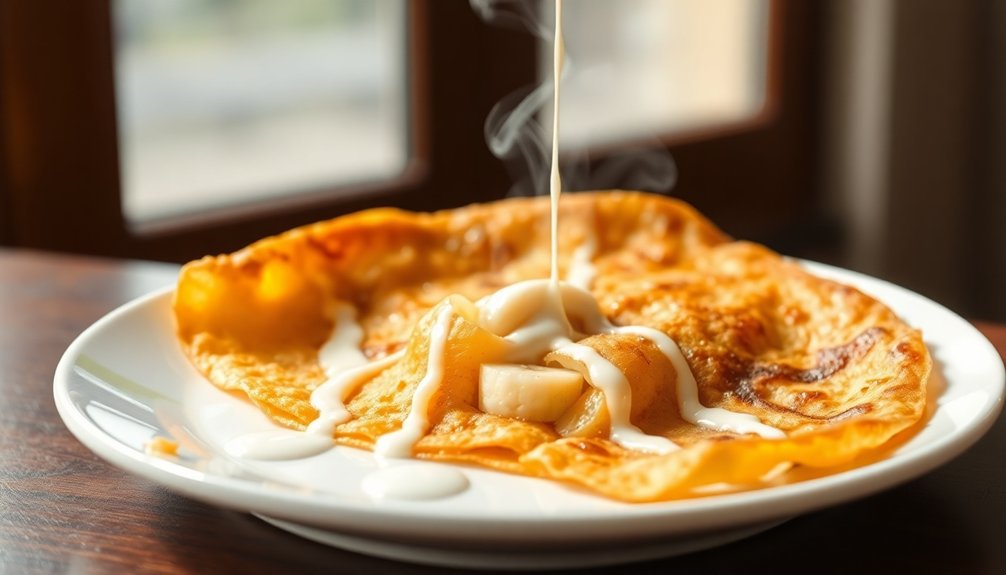
Mastering a few essential techniques will help you achieve the perfect roti gluay texture. When preparing this Thai street food favorite, pay attention to dough consistency and banana ripeness. The cooking temperature must remain consistent to create that signature crispy exterior while maintaining a soft, chewy interior.
1. Heat your griddle to medium-high before starting - it's ready when water droplets dance across the surface.
Don't start cooking until you've reached the right temperature.
2. Stretch the dough as thin as possible without tearing - you'll want it almost transparent to achieve those delicate, flaky layers.
3. If bananas aren't available, you can substitute with other soft fruits like mango or jackfruit, but adjust the cooking time accordingly to prevent burning.
Final Thoughts
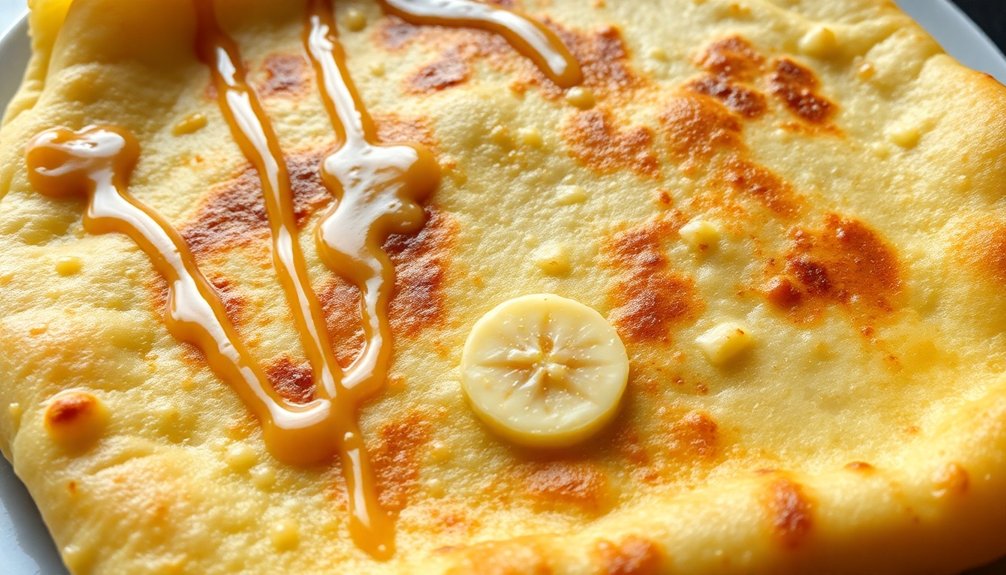
Armed with these cooking techniques, you'll be ready to create roti gluay that rivals any Thai street vendor's version.
This beloved street food has deep cultural significance in Thailand, where it brings people together and creates cherished memories of late-night snacking and casual dining experiences.
Don't be afraid to experiment with flavor variations once you've mastered the basic recipe.
You can try adding different fruits like mango or durian, or incorporate local ingredients that complement the banana filling.
Some cooks even add chocolate spread or peanut butter for a fusion twist.
Whatever variation you choose, remember that the key to perfect roti gluay lies in achieving that delicate balance between crispy exterior and soft, gooey center that makes this Thai treat so irresistible.
Frequently Asked Questions
How Long Can Roti Gluay Be Stored After Cooking?
You'll want to eat these fresh, but you can store them for up to 2 days in an airtight container. Reheat quickly in a skillet or microwave before serving.
Can I Substitute Regular Milk for Condensed Milk?
While you can use regular milk, it won't give you the same sweet, thick consistency. For best cooking tips, stick with condensed milk or try coconut milk as milk alternatives.
Why Does My Roti Gluay Turn Out Tough Instead of Crispy?
You're likely overworking the dough texture or cooking at too low a temperature. For crispy results, knead minimally and cook on high heat until bubbles form and edges brown.
Are There Any Variations of Roti Gluay in Other Southeast Asian Countries?
In over 90% of Southeast Asian countries, you'll find banana-based street foods. You'll love Malaysian Roti Pisang's buttery layers and Filipino Turon's crispy spring roll style with jackfruit.
What Type of Bananas Work Best for Making Roti Gluay?
You'll want cooking bananas that are fully ripe but still firm. Choose yellow bananas with brown spots - they're sweet enough to caramelize nicely while holding their shape during cooking.
